The Nexus 7 (2013) Review
by Anand Lal Shimpi on August 22, 2013 6:00 PM EST
Truth be told, Google has made (or at least directed the making of) some of the best tablets on the market today. The original Nexus 7 was groundbreaking in that it offered a totally usable platform, married to the latest version of Android, for $199. The Nexus 10 gave us a very quick, ultra high resolution 10-inch tablet for $100 less than the flagship iPad (and with more storage). Both were easily recommendable due to their value, but this year Google is stepping out of the shadow of value and into one of excellence. It starts with the new Nexus 7.
Based on the success of the original Nexus 7, Google went back to ASUS for the second version. In the 12 months since the release of the Nexus 7, the world has changed quite a bit. Expectations for value tablets had been reset by the original Nexus 7 as well as Amazon's lineup of Kindle Fires. Simply showing up with another good value likely wouldn't do anything to further the brand (or market). I get the distinct impression that Google isn't big on not changing the world.
| Nexus 7 Tablet Specification Comparison | ||||
| ASUS Nexus 7 (2012) | ASUS Nexus 7 (2013) | |||
| Dimensions | 198.5 x 120 x 10.45mm | 200 x 114 x 8.65mm | ||
| Chassis | Plastic + Rubber back | Plastic + Soft Touch back | ||
| Display | 7-inch 1280x800 IPS | 7.02-inch 1920x1200 IPS | ||
| Weight | 340 g | 290 grams (WiFi), 299 grams (LTE) | ||
| Processor | 1.3 GHz NVIDIA Tegra 3 (T30L - 4 x Cortex A9) | 1.5 GHz Qualcomm Snapdragon S4 Pro (APQ8064-1AA) | ||
| Memory | 1 GB | 2 GB DDR3L | ||
| Storage | 8 GB / 16 GB | 16 GB / 32 GB | ||
| Battery | 16 Whr | 15.01 Whr | ||
| WiFi/Connectivity | 802.11b/g/n, BT, NFC | 802.11a/b/g/n, BT 4.0, NFC | ||
| Camera | 1.2MP Front Facing |
5.0 MP Rear Facing w/AF 1.2MP Front Facing |
||
| Wireless Charging | – | Yes (Qi Compatible) | ||
| Pricing | $199/$249 |
$229/$269 (WiFi 16/32 GB) $349 (LTE) |
||
The result is the new Nexus 7. Identical only in name, manufacturer and screen size, the 2013 Nexus 7 is a downright Apple way to rev a product. Google made it thinner, lighter, faster and better in almost every way.

2013 Nexus 7 (left) vs. 2012 Nexus 7 (right)
The original Nexus 7 was rather thick but it got away with it since the overall footprint of the tablet was so small. The new Nexus 7 truly feels like a slate. It's the type of thing I expect to see carried around on the Enterprise.
I don't miss the rubber imitation leather from the original Nexus 7, it's replaced by a soft touch plastic back. You definitely don't get the premium aluminum feel of the iPad mini, but the device doesn't feel cheap either. The new Nexus 7 is still nice enough that I'm nervous about scratching or scuffing the back.
Both ASUS and Nexus logos are prominently featured on the back. ASUS continues to amaze me by just how far it's come as a company, and the new Nexus 7 is hands down its most impressive tablet creation yet. From a build quality standpoint I really have no complaints about the Nexus 7. While the MeMO Pad HD7 has some creaks and flex in the chassis, the new Nexus 7 feels like a solid slab of soft plastic and glass. It's nice.
Unlike the original Nexus 7, the new model features stereo speakers on back of the tablet. It's an easy feature to take for granted but going back to the old mono design sounds worse.
I agree with Brian that the power/lock and volume buttons are the only real sore spot on the physical execution. They aren't particularly well defined and feel a bit mushy. Even writing this paragraph feels like I'm nit picking though, the build here is really good.
The only other complaint I'd levy against the new Nexus 7 is that the design doesn't particularly stand out as being unique. The iPad has its aluminum, the Moto X has its wood, but the Nexus 7 falls victim to the fact that ultimately it's tough to make these ultra mobile devices stand out. You need a large glass surface and you need a back. Black also tends to be one of the easier colors to sell (get too creative and you end up with inventory problems). It's not a huge deal to me personally, but as mobile devices can often be fashion statements I don't know that the new Nexus 7 has all that much curb appeal.
The Display
What the Nexus 7 lacks in pizazz, it completely makes up for once you power on the display. The 7-inch 1920 x 1200 display produces colors that are not only vibrant but, for the first time ever in a Nexus device, accurate as well. Google really worked on color accuracy this time, with a two step calibration process - once at a high level by the panel maker and once again per device during final manufacturing. The result is just awesome:
The Nexus 7 display is not only visually appealing but stacks up incredibly well in our CalMAN display tests. Although it loses to the iPad 4, the Nexus 7 gets indiscernibly close in many cases and blows the non-Retina iPad mini out of the water. I won't even bother comparing it to everything else in the Android space, they don't hold a candle to it.
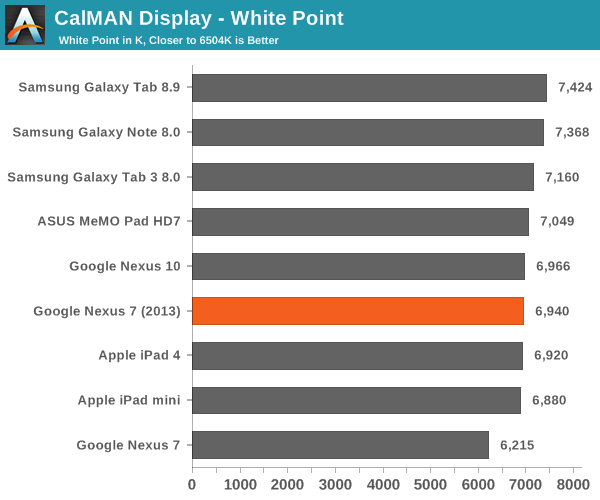
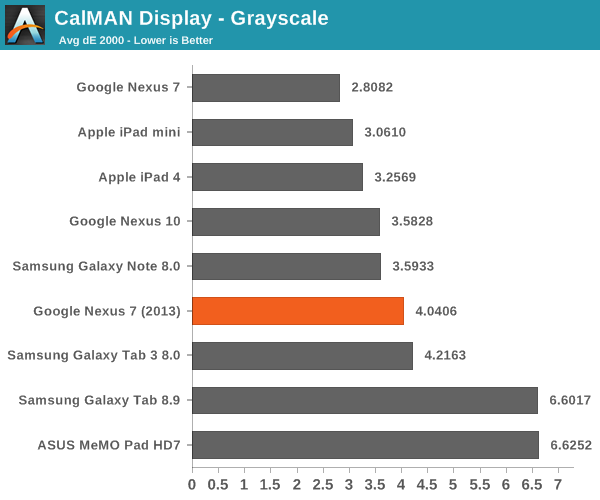
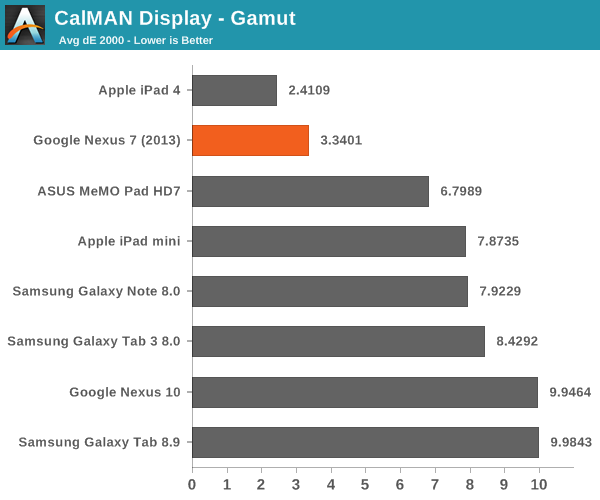
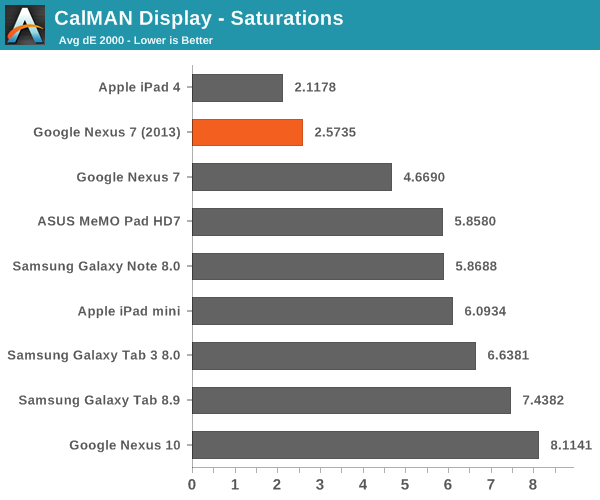
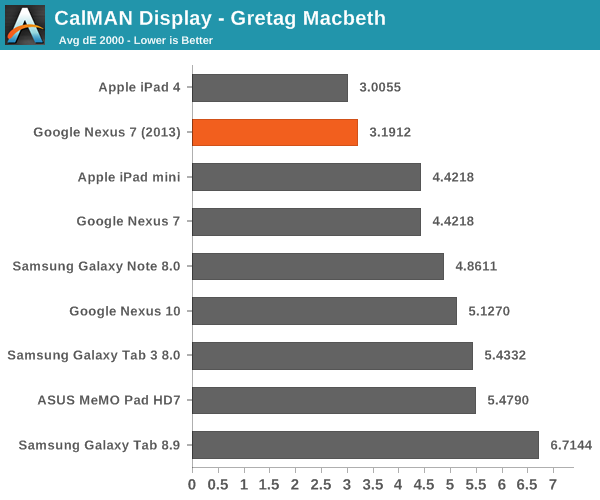
The new panel is also incredibly bright. I typically view 500 nits as the threshold for outdoor usability, and the new Nexus 7 definitely exceeds that threshold. The tablet will drink away all of your battery life if you leave it at this brightness setting indefinitely, but if you need to actually use your tablet outdoors for a while the Nexus 7 works.

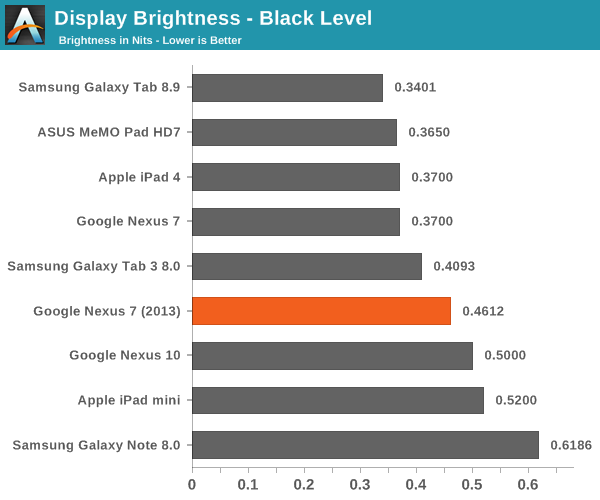
Black levels are a bit higher than on the original Nexus 7, but the resulting peak contrast ratio is still excellent:
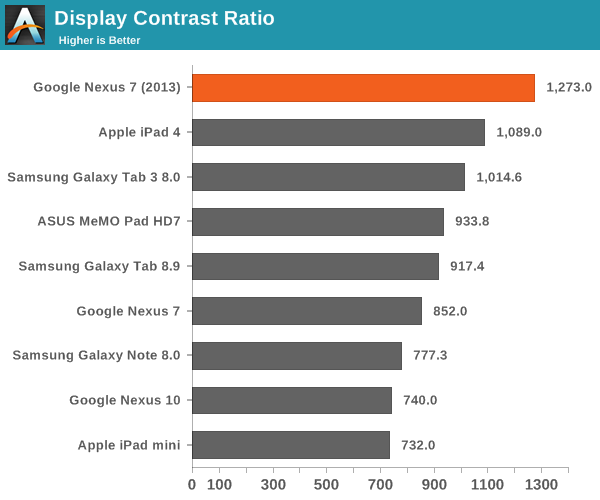
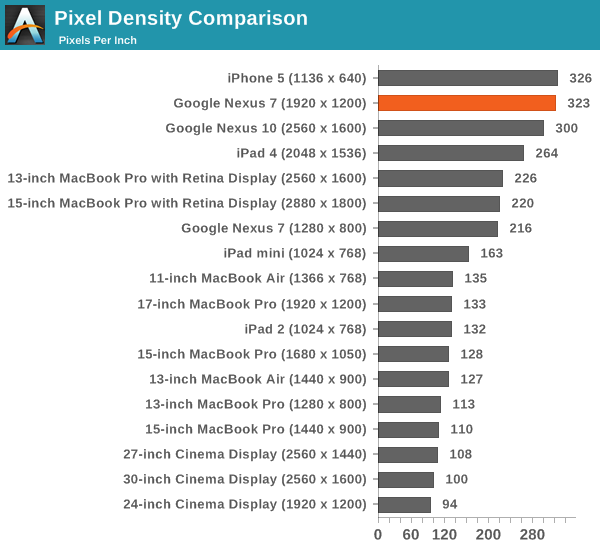
Pixel density shoots through the roof with the new Nexus 7 display as well. Brian was quick to point out that a major advantage of the Android platform is in its flexible resolution handling. The 1920 x 1200 panel presents itself as a 960 x 600 panel to web pages in Chrome, while other apps can use every last pixel for unique content (e.g. games).
The beauty of not having to double the original Nexus 7's resolution but instead settling on an in-between option like 1920 x 1200 is that Google could get away with a performance mainstream SoC instead of something ridiculously high-end.
The display looks great when viewing everything from photos and movies to web pages and eBooks. My only complaint about the Nexus 7's display is its size. A 7-inch tablet is almost pocketable (in fact I did carry it around in my pocket for a day), but the screen can feel a little cramped.


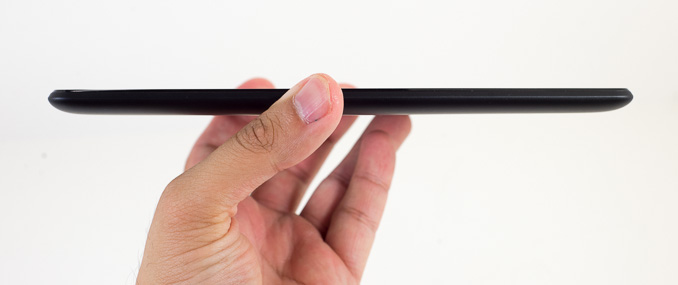
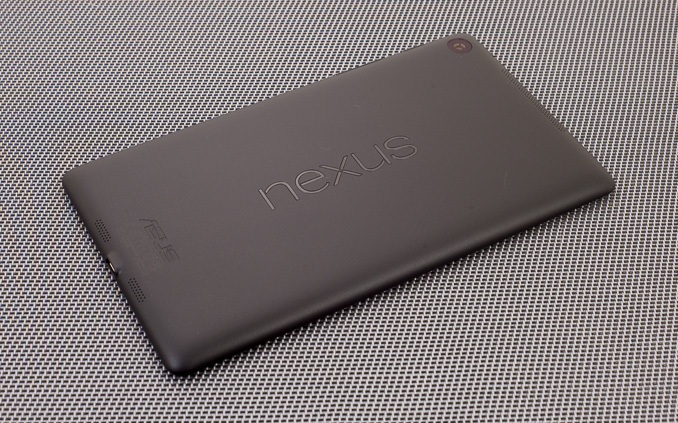
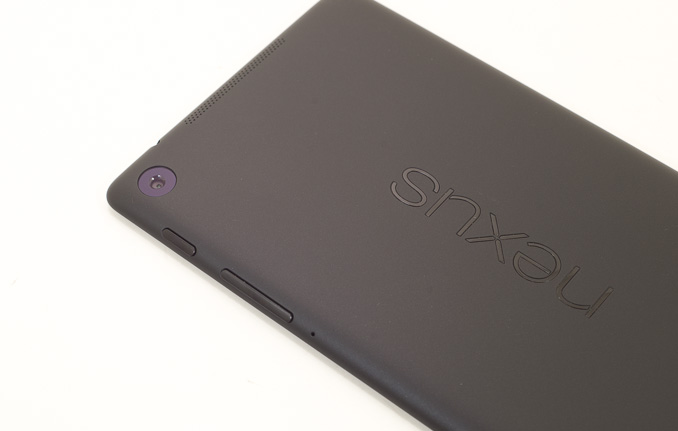


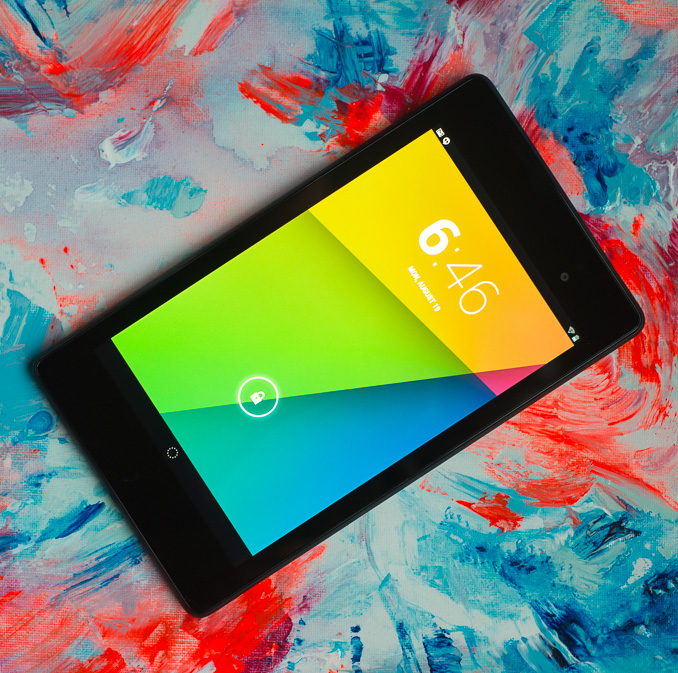
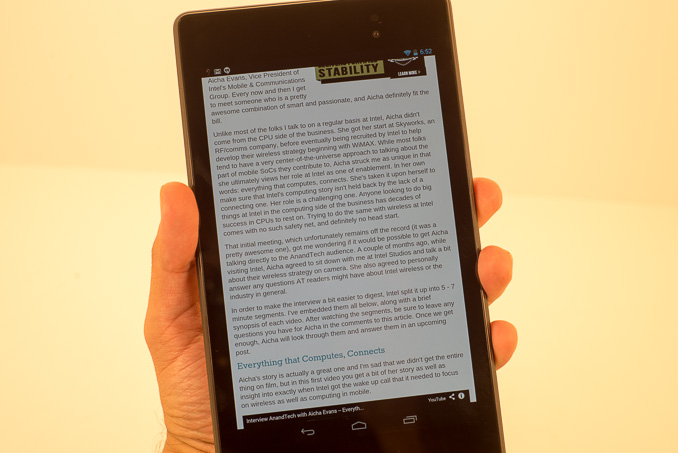
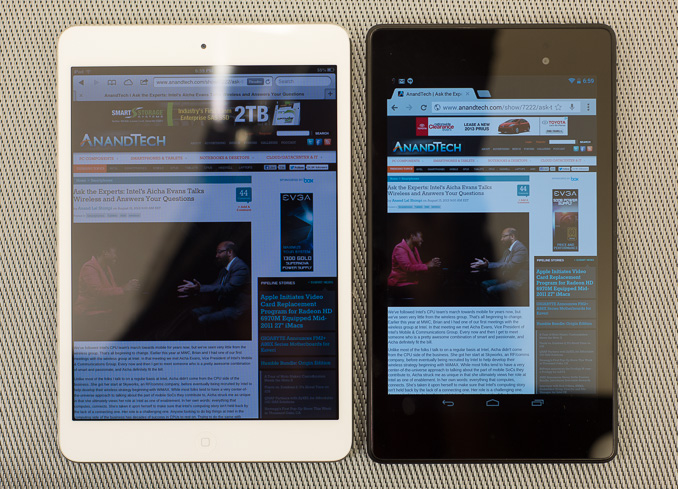








202 Comments
View All Comments
eio - Friday, August 23, 2013 - link
After playing with the new Nexus 7, I seriously think that equip the same 7" screen with a ultra-thin border (like Optimus G2) would be the ultimate form factor of smartphones. It won't be as comfortable to carry as a 5" but the enlarged screen size are much more beneficial for a portable computing device, which what smartphones are nowadays (imo they are not "phone" anymore, everyone is looking instead of talking to them). I can carry a 7" device in my back pocket without much problem, daily.meloz - Friday, August 23, 2013 - link
I so wish this tablet had a 9-inch screen. Then it would be perfect for me. 7-inch tablets do not work for me because of text size; you cannot hold them down (at lap level when sitting in chair) with the the wrists resting on legs. You always have to raise them up like a smartphone to chest height, and that gets tiring if you are sat and reading a long document/file.I wish Asus and Google would make a 9 inch variant of this device. :(
cjs150 - Friday, August 23, 2013 - link
Do what I did. Get a Nook HD+ and root it back to standard android. Although I would also strongly recommend getting a matt screen cover because of the reflections.Works really well as an e-book reader
ShieTar - Friday, August 23, 2013 - link
I just imported myself a Cube U30GT. Its a 10", but surprisingly enough they managed to keep it to 320g, so its as comfortable to hold as most 7" tablets. I can definitely hold it comfortably with one hand while operating the screen with the other one.aniym - Friday, August 23, 2013 - link
Since when did 659g become 320g? Seriously, this spamming of Chinese tablets is getting tiresome? Do you really think that readers of Anandtech, of all sites, are going to fall for your BS?meloz - Friday, August 23, 2013 - link
ShieTar, does your "Cube U30GT" (never head of it before, strange) posses identical specs and performance as the Nexus 7?Somehow I doubt it. I am not interested in disposable Chinese junk.
ShieTar - Monday, August 26, 2013 - link
Nope, it does most certainly not have identical specs and performances. The CPU is admittedly on the slow side, and the hardware is the kind of plastic you expect from a 200$ tablet. I did not try to tell you that it is better in every aspect then the Nexus 7, I merely expected that your reason for wanting a 9" when there is already a ton of 10" devices would be weight, and I offered a comment on that topic.ASEdouardD - Saturday, August 24, 2013 - link
Yeah, it'S 670 g. Way more than 320. Also, I'd stay for away from cheap Chinese tablets for now. Tablets are computers. So many things can go wrong, I have to really trust the company I'm buying this from. I'm sure China (and hey, I don't consider Taiwan part of China) will get there soon and produce high quality tablets, but we're not there yet. Anyway all Android tablets are crap except the Nexus line anyway.ASEdouardD - Saturday, August 24, 2013 - link
To each his own. I feel 7 inch is the best size for me. I find even the iPad Mini too big to carry around a lot. The iPad 4 and the Nexus 10 are just way too big for that. They're more couch tablets then follow you everywhere tablets. I don't even realize I'm carrying around my new Nexus 7 in my man purse (it's European!) because it's so light and small.ASEdouardD - Saturday, August 24, 2013 - link
''than''. Sorry.